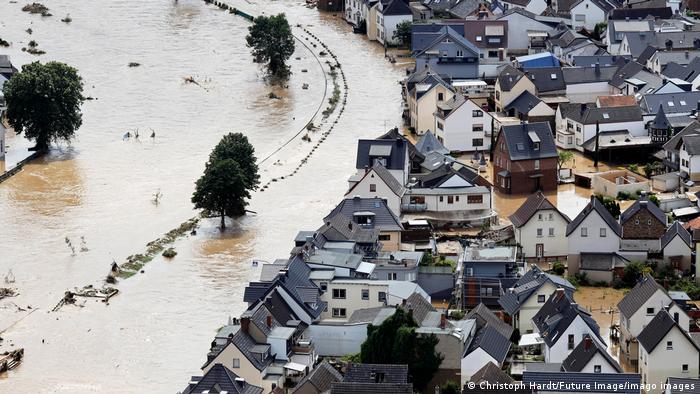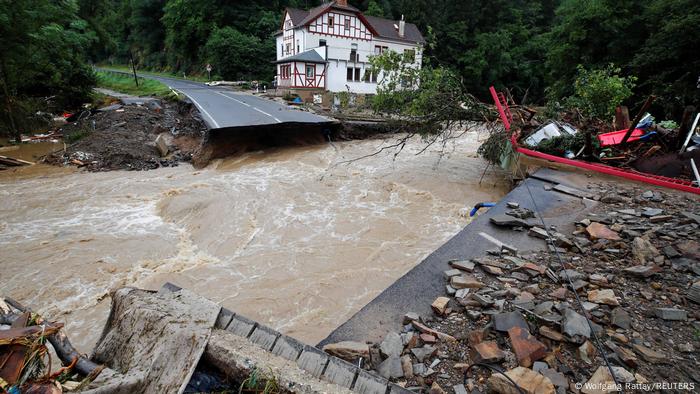Johan Nijenhuis has produced a film and a series focusing on the risk of storms and floods in his native Holland. He tells DW why disaster preparedness was his focal point.

"The flooding in western Europe has created more awareness than any series can"
Dutch film producer Johan Nijenhuis was a 16-year-old exchange student in Los Angeles, California, when he experienced his very first earthquake drill.
"Everybody was instructed what to do when an earthquake hits Los Angeles. All the students had to get under the table. We were told how to feel the aftershock, what to do when the building comes down, and where to gather to meet rescue workers," he explained to DW.
At the time, he wondered aloud how his Californian friends could live their whole life in an area prone to earthquakes. They retorted that he was one to talk, since he hailed from a country where much of its landmass is below sea level.

Nijenhuis time as an exchange student in Los Angeles helped develop his awareness of the need for disaster preparedness
"From their point of view, we're the silly ones. The strange thing is we never train for it. I guess it's the same thing for the German towns that are affected now," Nijenhuis said, referring to the recent deadly floods that devastated swathes of western Germany. "It's never really at the top of our minds what to do when the water comes," he added.
Be prepared — always
It was this reality that inspired him to create and produce both a film and a miniseries that focus on the damage caused by storms and floods.
Preparedness — or the lack of it — was a focal point of his six-part Dutch miniseries called The Swell. The 2016 production imagines what happens when the most powerful storm in history hits the Netherlands and neighboring Belgium. The drama features several storylines: A prime minister contemplating mass evacuations, prison wardens facing agitated inmates in a prison located below sea level, and a family grieving the loss of a child washed away by the waters.
While researching for the miniseries, Nijenhuis stumbled upon some intriguing reports. One was on an emergency drill once conducted by Dutch fire and emergency services that involved evacuating 60 residents of a senior care home. This included immobile residents who had to be evacuated with their beds.
"And they [the emergency services] did a wonderful job. They had the first person out within two hours! So imagine: What would happen if you had to evacuate 60 elderly people? ... You have to get these people out in the proper way."
That drill's outcome contrasts with what happened last week in real-time as floodwaters hit Sinzig, a town in the badly flooded district of Ahrweiler. There, 12 individuals in a home for disabled people drowned because they could not be evacuated in time.
While Nijenhuis hasn't been personally affected by any flood events, he researched flood risks in Amsterdam after his ex-wife, whom he calls a "prepper" — someone who prepares for catastrophic eventualities — suggested they move out of their home to someplace on higher ground.
"I found out that Amsterdam is actually a pretty safe place. The historic center is on high enough ground," he said. Yet very few Dutch know how high their homes are and what flood risks they could face, he added.
German flood victims were largely caught unprepared for the scale of the devastation, and many are now asking why authorities didn't act on an extreme flood warning that was issued early last week by the European Flood Awareness System (EFAS). Professor Hannah Cloke, the hydrologist who set up and advises EFAS, told Politico that the death toll in Germany was "a monumental failure of the system."
"I would have expected people to be evacuating. You don't expect to see so many people dying from floods in 2021," she said.

The capacity of rivers to cause extensive damage was underestimated, such as in the town of Schuld
Art presaging reality
Nijenhuis also produced The Storm in 2009. The film is set against the 1953 North Sea flood that struck the Netherlands, northwest Belgium, England and Scotland. A combination of wind, high tides and low pressure caused the sea to breach most water defenses, resulting in land flooding of up to 5.6 meters (18.4 ft) above sea level.
This led to the construction of the Delta Works in the southwestern Netherlands, an extensive series of devices at the mouths of most estuaries that can be closed in an emergency and prevent flood surges.
"The film [The Storm] was of course inspired by the historic events, but the series [The Swell] is very much inspired by how well we are protected now. When I did research for the series, I found that most people in the Netherlands do worry about the sea flooding the land. But in fact, rivers flooding the land are a far more realistic danger," Nijenhuis said.

Aerial view of a section of the Delta Works, which protects millions against flooding in the southwest of the Netherlands
Climate awareness or unnecessary fear?
Can a series like The Swell, or films and books with similar angles, help create more awareness about climate change, or do they trigger unnecessary fear instead?
Nijenhuis said that going by the reactions he saw on Twitter to the miniseries, "The danger did become real to many people, and the ones who got worried did their research."
However, he said that the recent flooding in western Europe has created far more awareness than any series ever can.
"The fact that climate change is here is something I think 99% of the people of both our countries agree upon and perhaps question in what part human behavior has contributed to it. Climate change is here… it's almost too late to stop it. The thing we should learn now is how can we protect ourselves."
Heed the warnings
Despite producing a film and a series that somehow eerily presaged the current state of affairs in western Europe, Nijenhuis said he is not a pessimist.
He has observed that how people treat the planet changes every 50 years. Transportation, for instance, has transitioned from water-based to land-based methods, he said.
"Same goes for the way we use energy. One hundred years ago, it was coal and wood. And then we changed to gas, and now we have to move to solar panels and maybe nuclear energy. These changes happen every 50 or 100 years, and the same goes for the way we protect ourselves from the water."
This, however, means rethinking where homes should be built. Nijenhuis explained how in the Netherlands, farmers' warnings against building homes too close to bodies of water have sometimes gone unheeded — to the eventual detriment of the homeowners.
"We have to have a good look at where we build houses. From the series, I learned that certain areas will be affected by floods and swells. You can't prevent a floor getting wet now and then; we should only make sure that we don't have tragic deaths when it happens."
No comments:
Post a Comment